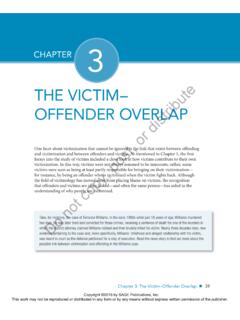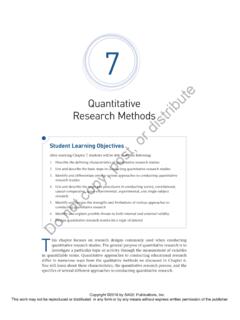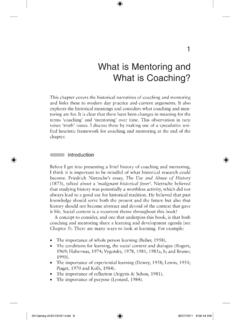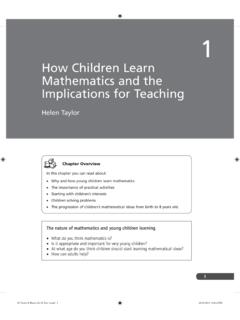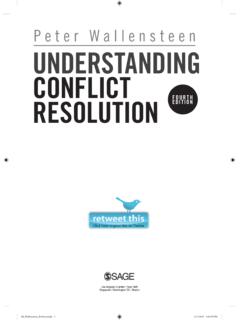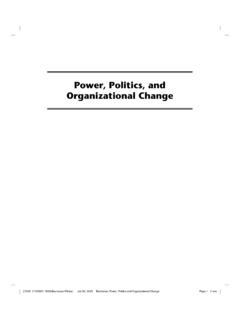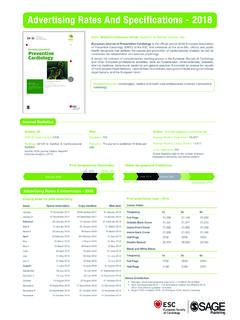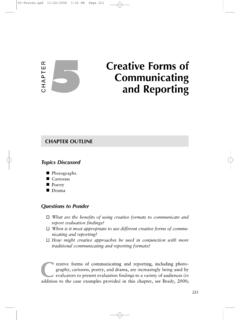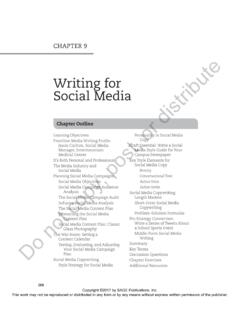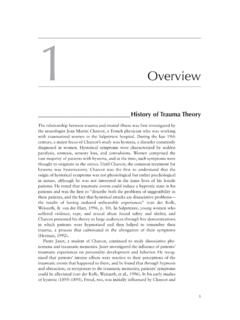Transcription of Pretesting and Pilot Testing distribute
1 1016 Pretesting and Pilot TestingINTRODUCTIONIn this chapter, we detail the possibilities and pitfalls presented by Pretesting , the methods of validating the survey instrument and its measurements, and Pilot Testing , the dress rehearsal of survey administration and procedures (Rothgeb 2008, 584). Pretesting and Pilot Testing are invaluable components of survey research, affording researchers a valuable opportunity for reflection and revision of their project before the costs of errors begin to multiply later on. We begin this chapter with a discussion of the goals of and guidelines for Pretesting followed by a summary checklist to help you make the most of this procedure. Then we provide an elaboration of the broader process of Pilot Testing the entire project from start to finish.
2 If you pay close attention to the issues outlined in this chapter, Pretesting and Pilot Testing could lead you to that early stitch in time that saves countless dollars and hours later on down the you have a complete draft of your survey, a pretest is a necessary next component of the research process. Pretesting your survey is an important way to pinpoint problem areas, reduce measurement error, reduce respondent burden, determine whether or not respondents are interpreting questions correctly, and ensure that the order of questions is not influencing the way a respondent answers. In other words, a pretest is a critical exam-ination of your survey instrument that will help determine if your survey will function properly as a valid and reliable social science research tool (Converse and Presser 1986).
3 Copyright 2016 by SAGE Publications, Inc. This work may not be reproduced or distributed in any form or by any means without express written permission of the publisher. Do not copy, post, or distribute102 SECTION II: QUESTIONNAIRE DESIGNU sing a pretest of the survey, researchers are able to ensure that the questions are clearly articulated and that the response options are relevant, comprehensive , and mutually exclusive and not just in their own estimation, but from the point of view of the respondents as well. Making sure that researchers and respondents interpret the survey in the same way is of the very highest concern in survey design , and pre- Testing is one of the best ways to do this (Converse and Presser 1986).
4 Pretesting can bring to light those inevitable instances of obscure terminology, unfamiliar references, and ambiguous words and phrases that the developer did not initially see as problem-atic, but that could confound and frustrate the respondent and hurt data quality and response rates. Furthermore, the pretest also allows the researcher to assess response latency, the amount of time it takes to complete individual items in the survey as well as the full survey, which can then be reported in the introduction of the full-scale survey ( for reasons discussed in Chapter 3; Bassili and Scott 1996; Draisma and Dijkstra 2004).Another important feature of Pretesting a survey is the technical report (paper trail) left for future research endeavors.
5 When a survey researcher has conducted similar research in the past, and has pretested and sufficiently documented survey materials, these tried and true measures help design a valid survey instrument. Thus, a meticulous record of the pretest process helps avoid future problems encountered at the various stages of study considering research funding sources, Pretesting your survey instrument prior to full-scale administration lends credibility to your proposed work and account-ability to you as a researcher, which could also potentially increase the probability of obtaining research also serves as practice administration and a way to evaluate respon-dents understanding of the concepts under study as well as the quality of their inter-views (Converse and Presser 1986).
6 All respondents should understand the concepts and ideas in the same exact way. In the following example, housework may be inter-preted differently by men and women and by individuals with and without children. Some might argue that childcare is included in housework, while others might argue that it is not:1. Considering your work and commute schedules, would you say the division of your housework is fair?1) No, I do way too much of the ) No, I do somewhat more than I ) No, my partner does way too much of the ) No, my partner does somewhat more than she/he ) Yes, it is fair enough. Copyright 2016 by SAGE Publications, Inc. This work may not be reproduced or distributed in any form or by any means without express written permission of the publisher.
7 Do not copy, post, or distribute103 Chapter 6 Pretesting and Pilot TestingChoosing not to pretest a questionnaire poses a potentially serious threat to the accuracy of the survey questions and resulting data. It is better to pretest a questionnaire on even just one person rather than field the survey without Pretesting . The rule of thumb is to test the survey on at least 12 to 50 people prior to Pilot Testing or full-scale adminis-tration (Sheatsley 1983; Sudman 1983). This is a cost-, energy-, and time-efficient number of people a large enough number that many will note the same problems with the sur-vey questions. Inclusion of more than 50 test respondents may lead to the identification of more problems, but there comes a point of diminishing return, as the financial and time costs of further Pretesting outweigh the benefits of discovering more relatively small issues and inconsistencies in the time involved in Pretesting a survey (and the posttest assessment) depends largely on the length of the survey.
8 The following section discusses who should partic-ipate in a survey pretest ( , the sample of Testing participants), how the pretest should be carried out, how to collect pretest data, and what to do with feedback from the survey PretestsResearchers sometimes call upon experts in a given field to identify problems with ques-tions or response options in a survey (Presser and Blair 1994). For instance, a child behavior specialist may help pinpoint measurement issues in a newly developed child behavior checklist. As noted in Chapter 5, expert-driven pretests are crucial when assessing the face validity and construct validity of a might ask experts to pretest your survey items by going through the entire survey themselves, and, rather than asking them to provide an individual assessment of each item, ask them to rate the items on a Likert scale such as that outlined below.
9 The idea is not to collect the experts opinions and beliefs but to get their judgment of how well each questionnaire item truly reflects the construct you intend it to measure ( Jansen and Hak 2005). Soliciting such expert appraisals of each and every survey question, using Likert-type scale items such as those below, can be an extremely valuable strategy for identifying problems and fine tuning items to collect optimal measurements:1) Very strongly represents the construct2) Somewhat strongly represents the construct3) Unsure4) Somewhat weakly represents the construct5) Very weakly represents the construct Copyright 2016 by SAGE Publications, Inc. This work may not be reproduced or distributed in any form or by any means without express written permission of the publisher.
10 Do not copy, post, or distribute104 SECTION II: QUESTIONNAIRE DESIGNE xperts are important not only for cross-checking the substantive aspects of the survey but for improving the overall style of the instrument as well. With their finer knowledge of the breadth of the given field, experts can tell you if all questions in the survey are relevant and necessary, or if some may be cut to shorten the ques-tionnaire length and reduce respondent burden. They can also help decide if the survey flows seamlessly from one question to the next, thus following a logical and intuitive layout that again reduces respondent burden and improves the quality of your data (Olson 2010).Finally, whether you have access to experts in the relevant field(s) or not, you can familiarize yourself with some of the extant expert research in the field, as well as with previous surveys on the same topic, to compare your newly designed measures to those in the established PretestsAdministration of the pretest survey to friends and colleagues is encouraged.
